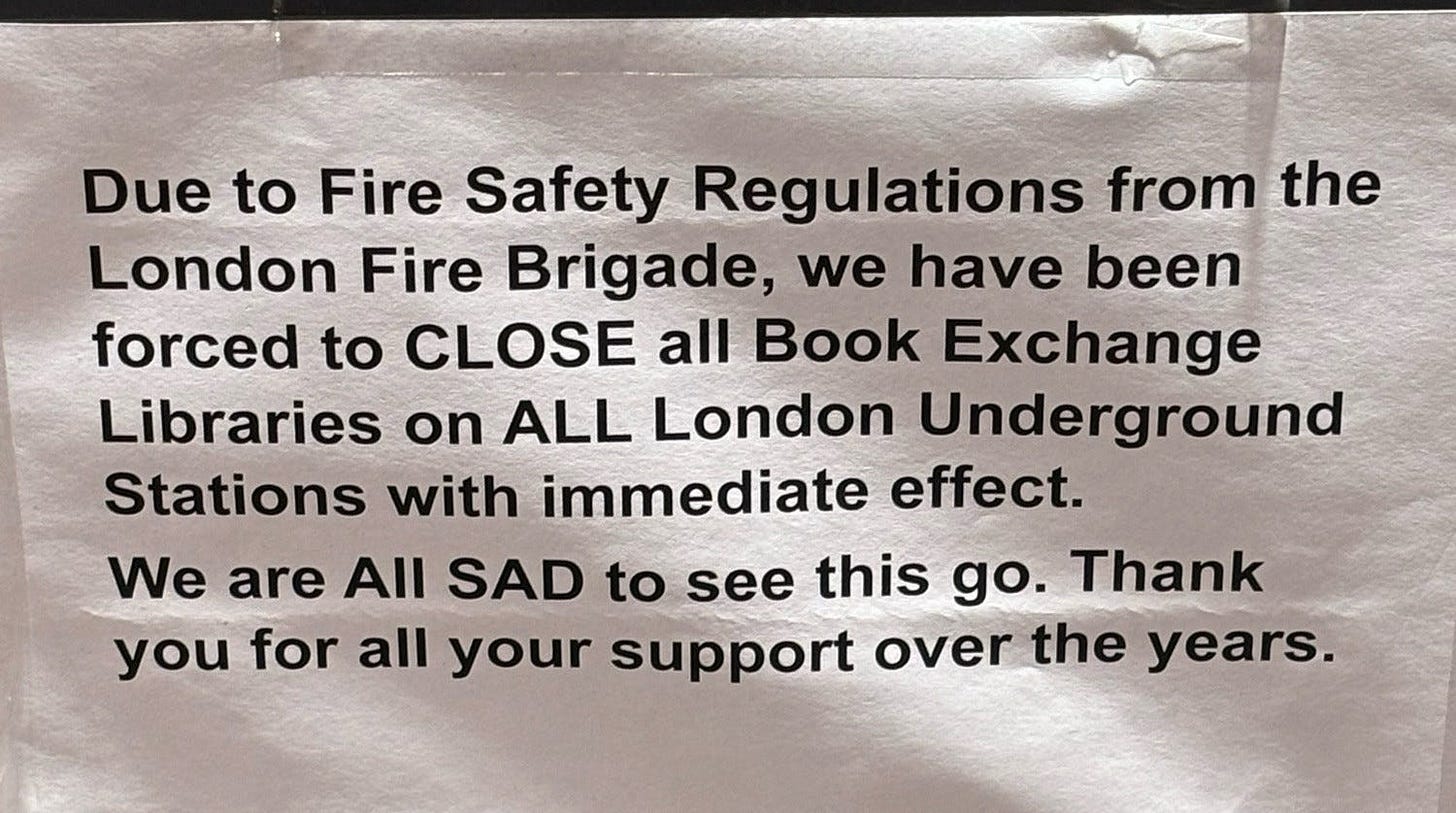Will tube drivers get a four-day week?
Plus: The mysterious east London "morality police" wreaking havoc with red paint and Sadiq Khan's plan to rescue London Underground libraries.
If you want an example of how modern journalism works — and what makes London Centric different — you could do worse than checking out the Daily Mail on Thursday. We woke up that morning to texts from readers who saw the newspaper had published an investigation into London’s knock-off Harry Potter shops that was remarkably similar to the story London Centric covered back in December.
Three months on from our original report, which was only available to paying to subscribers, we’ve made it available to read for free for a short period of time. If you like what you’re reading, please spread the word and consider signing up to get the paywalled investigations first. We can’t compete with big newspapers when it comes to reach or publicity, but our commitment to reporting properly on the stories that matter to our readers is genuine.
This week I went on the Andrew Marr show on LBC to discuss Tuesday’s report on the Port of London Authority. After mentioning our other story on the City of London’s parks, he said: “If you’re interested in what’s really going on in London right now then check out London Centric.”
We’ve got some more big investigations that fit that description coming in the next few weeks.
How the London Underground book libraries were lost — and why it might be hard to bring them back.
Within a day of the story breaking that book exchanges in tube stations had been banned on fire safety grounds (London Centric readers kindly tipped us off ahead of many other publications) Sadiq Khan’s team were able to brief that the mayor would overturn the decision.
On one level, the initial choice to ban book exchange libraries might appear to be an example of petty bureaucracy run amok. But all fire safety rules on the London Underground ultimately lead back to the King’s Cross Fire of 1987, one of the worst disasters ever to hit the capital’s transport network, when a discarded match hit some litter and created a ball of fire that killed 31 people.
As memory of the fire has faded, the libraries have spread across the tube during the last decade. These were usually ad-hoc ramshackle affairs where shelves have been put up by local staff or commuters, where people could drop off the book they had just finished and pick up a new read.
The rules on sub-surface stations were last updated in 2009. They clearly state that all parts of the station must be kept clear of “any accumulation of combustible refuse or other combustible matter” and any area set aside for such material must be separated from other parts of the building with “fire-resisting” material.
What happened this week, sources told London Centric, is that someone at London Fire Brigade pointed out to Transport for London that, based on a strict reading of the law, the book exchanges should never have been allowed at stations in the first place. Once TfL had been informed of this interpretation of the law, they had little choice but to close the libraries down with immediate effect. Following the mayor’s intervention, the race is now on to find a suitable fire-safe solution to replace the old ad-hoc shelving units. The challenge will be finding something that is compatible with a fire safety law that leaves little leeway.
The current strict set of fire safety laws from 2009, which caused such confusion this week, were guided through parliament in the final days of Gordon Brown’s Labour government by an ambitious junior minister, who told parliament the intention was to “modernise and simplify” the legislation. That minister’s name was Sadiq Khan.
Preposterous London property of the week.
London Centric’s ongoing trawl of the capital’s silliest, most expensive, and excessive properties has landed on something special: A five-bedroom house in Hampstead for a mere £11 million. There is something inherently preposterous about prices at this level but the interior of this 1960s modernist house, built for furniture magnate Chaim Schreiber, is quite incredible. It’s also well-located for observing two intriguing stories: The ongoing battle over whether the City of London should continue to subsidise Hampstead Heath — and the tree in the woods opposite the house that has been at the centre of a gay cruising dispute.
Who is daubing London houses with “brothel” graffiti?
A mysterious group appears to be engaged in an ongoing campaign targeting homes across north and east London, daubing houses in red paint and scrawling unsubstantiated allegations on their walls (reports London Centric’s Rachel Rees). All of the incidents seem to follow the same pattern: Individuals turn up in the middle of the night, use tins of paint to disfigure homes, then write the word “brothel” on the outside.
Incidents have taken place in Kilburn, Hampstead and Leyton over the last 18 months. What’s less clear, according to police and officials, is the link between the incidents, how many people are involved, or why these particular properties were targeted. One local resident suggested the incidents were the creation of a “vigilante morality police”.
On Thursday London Centric visited the site of one of the latest graffiti attacks in Walthamstow, where a council cleaner was power-washing the paint off a nondescript Victorian suburban house. They said they had dealt with multiple similar incidents in recent weeks, with another address in Leytonstone also targeted last week.
A shopkeeper who captured the Walthamstow attack on CCTV told London Centric the incident involved multiple people wearing gloves and masks, who covered a flat in paint shortly after 2am. One neighbouring family whose flat was splattered in paint in the attack was woken by their young child saying that there was “blood all over the windows”.
Neighbour Tom Bulpett told London Centric that "nothing like this has happened before" and new residents moved into the targeted flat two weeks ago, replacing a group of delivery drivers who had lived there previously. There is no evidence any of the buildings targeted were being used as brothels. Prostitution is legal in the UK but owning or managing a brothel is not.
A spokesperson for the Metropolitan police said of the latest attacks: “We are aware of a number of incidents whereby addresses in the Leytonstone area have been criminally damaged with red paint in the last month. These incidents are being investigated by the local Safer Neighbourhoods Team to ensure all investigative leads are explored and support is provided to the victims of these incidents. At this stage there has been no arrest and enquiries into the circumstances continue.”
If you have anything to add to this story, then get in touch via WhatsApp or email.
Tube drivers in fresh push for 32-hour working week.
London Underground drivers are making a fresh push to reduce the length of their working week to 32 hours, according to internal communications seen by London Centric.
As part of a pay deal to avoid strikes last autumn, Transport for London (TfL) agreed to draw up a proposal on how drivers could shift to a four-day working week model, ensuring drivers always have a clear day off for rest.
Earlier this month the transport operator went to unions with a “take-it-or-leave it” deal: Keep the existing 35-hour five-day working week, or squeeze the same contracted hours into four days.
An internal email sent to drivers belonging to the Rail, Maritime and Transport Workers union (better known as the RMT) raised safety concerns about this plan to ‘compact’ the working week and said contracted hours should also be cut at the same time.
The email said: “More handle time [the time spent driving trains] and the squeezing of walking time and other non-driving time is proposed in order to shoehorn the same amount of driving into four days. RMT has serious concerns about the safety of extending the working day. Fatigue needs reducing, not increasing, on those days when you are at work.”
A four-day working week is common for drivers on other parts of the rail network, including the London Overground and Elizabeth line. Tube drivers have long wanted the same system, along with a reduction in working hours.
TfL’s proposal for a four-day working week would see drivers paid for their daily 30 minute lunch break for the first time. It argues that the actual time each driver spends at work each day would therefore not be much longer than under the existing five-day system.
The RMT drivers were told the demand for a 32-hour week would be raised again in the next round of pay negotiations later this year. The email also objected to the way TfL wants to phase in its proposals for a four-day working pattern, which would require drivers to accept increased use of apps for booking on to shifts and for drivers to accept greater flexibility, such as switching depots with 24 hours notice.
A national spokesperson for the RMT told London Centric: "We have received a proposal from London Underground and our members are considering its contents."
Tube drivers are represented by two different unions. ASLEF, which represents the majority of drivers, also has a longstanding objective of securing a 32-hour week but has not made it a demand in the next round of pay negotiations.
A TfL spokesperson ruled out cutting drivers’ hours any further and said its own proposals for a four day working week would “improve reliability, improve our ability to flexibly deploy our drivers and enable us to offer a modern and efficient service while creating no additional costs”.
“This work was a condition of the pay agreement that we came to with our unions last year, and details how we could make the changes to working patterns while ensuring that they benefit our customers as well as our colleagues.”
Did you enjoy this edition of London Centric? Please forward it to a friend, get in touch via email or WhatsApp, or leave a comment.







It sounds like a four-day week makes sense, and if it's the norm on other London rail services then I don't see why it would be controversial for Tube drivers to also have it. The fact that different arms or areas of TfL have different working conditions for people doing the same job at all is somewhat ridiculous, the kind of institutional bureaucracy that TfL should be working to minimise.
Wait until TFL realise many of their stations are also made of wood